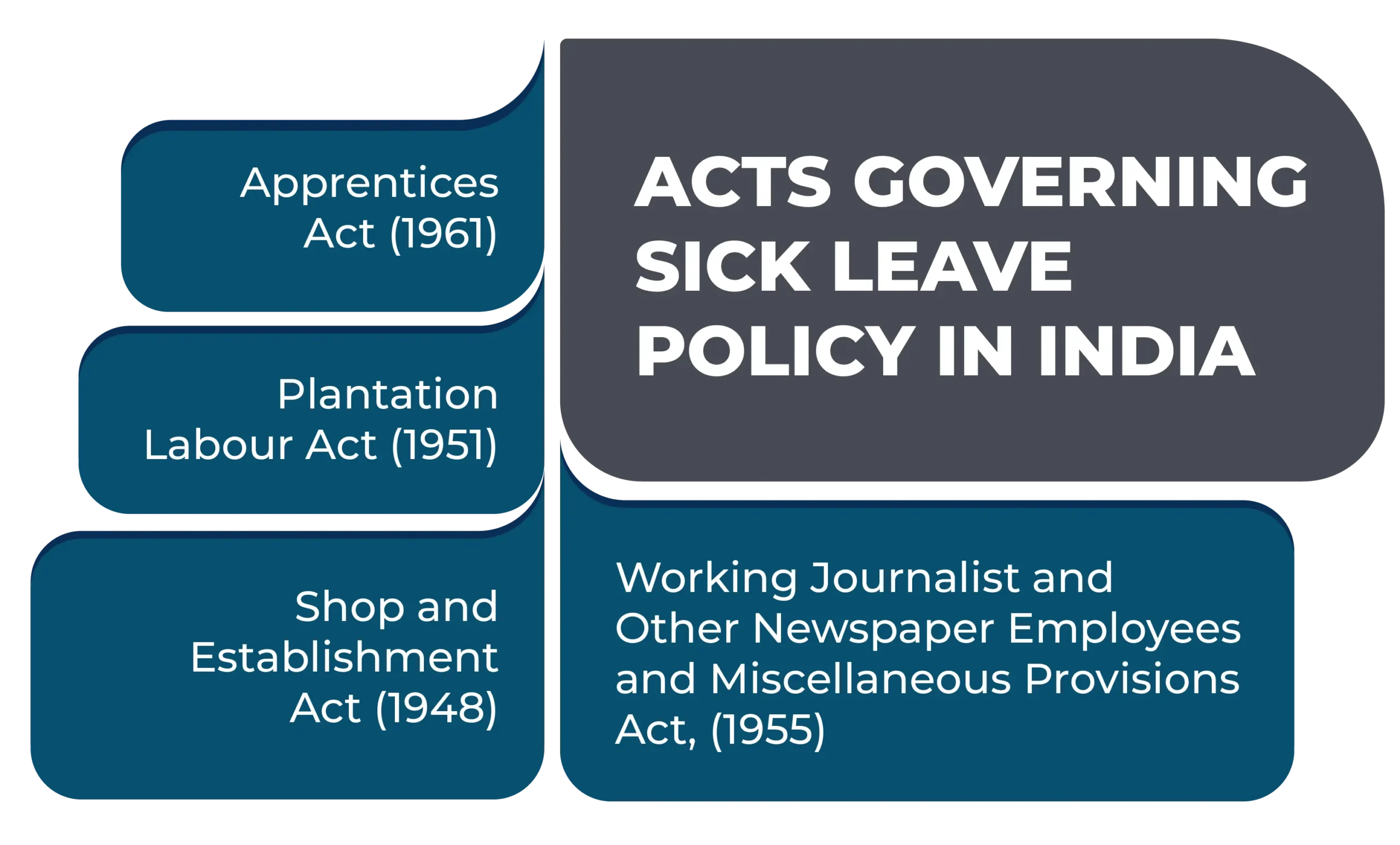What is Sick leave?
Sick leave is a paid time off that every employee receives when they feel sick or unwell or need to speed up their health recovery. In India, employees receive a minimum of 10 days of sick leave, but according to different acts and policies, private companies can customise it as required. It also covers mental and physical health issues, medical appointments, hospital stays, or recovery from surgery, depending on company policy or local labour laws.
However, acquiring sick leave depends on the policy. Still, nowadays, it is mandatory for every company as employees are satisfied about knowing their leave count, and moreover, it maintains a work-life balance as well.
Sick Leave Policy
Numerous acts and policies define when employees can receive sick leave and how many leave can be acquired during one financial year. The following regulations govern the eligibility, duration, and salary for sick leave in India.

1. Shop and Establishment Act
The Shop and Establishment Act ensures that government employees receive a minimum of 0.5 days to a maximum of 7 days of paid leave. However, if the leave taken is more than 3 days, employees must provide a medical certificate as proof.
2. Apprentices Act (1961)
The Apprentices Act is mainly for interns. According to this act, interns can take a maximum of 15 days of sick leave in a financial year, with the option of accumulating up to 40 days a year. Interns come for a particular internship that takes a maximum of 12 months, but sick leave reimbursement is also ineffective for office interns.
3. Plantation Labour Act (1951)
The Plantation Labour Act (1951) ensures plantation workers can take one day off every 20 working days. However, according to the Act, employers can follow their drafted rules or policies when calculating annual leave. Most private sector employers arrange their yearly leave calendars according to the Act.
4. Working Journalist and Other Newspaper Employees and Miscellaneous Provisions Act, 1955
This act is only applicable to working journalists and newspaper employees. They are eligible for one month of sick leave for every 18 months of service. However, in that scenario, they can only use half of their payment.
Who will receive sick leave?
However, it feels weird when we come to this part, like who can receive sick leave? As it is directly related to employee well-being, it must be available within the annual leave calendar. However, there is some segregation between paid and unpaid sick leave. In India, sick leave eligibility is based on employment terms.
➔ For the Government Employees
According to the Central Civil Service Rules 1972, government employees can take 10 to 20 days of leave, including both leave and casual leave. If employees take extended time off for long illnesses, it is considered commuted leave for extended sickness with a proper certificate. For government employees, unused sick leaves easily carry over to the following years.
➔ For the Private Sector Employees
According to the Plantation Labour Act, the credited sick leave count solely depends on the individual companies. However, many companies follow the legal minimums outlined in the Factories Act 1948, where companies ensure employees receive time off for 12 days for one financial year. Some big MNCS exceed the leave count from 12 to 15 or 18. Yet, the one thing remains the same for government and private employees: employees must show a medical certification if they take more than 3 days off altogether due to illness.
➔ For the Gig Workers
There is no sick leave policy for the contractual employees or the gig workers. They are not covered under recent labour laws like the Factories Act, the Shop and Establishment Act, and the Plantation Labour Act, 1951, unless companies voluntarily provide them. In companies, contractual employees get paid hourly or daily for their work output. So, taking leave for their illness is considered a non-paid day off rather than sick leave. However, the part-time employees also often have limited or no sick leave privileges.
Why are Sick leaves important?
Sick leaves are often misunderstood as a day off. Many companies arrange the leave as a lump sum rather than segregating it from different leave types. However, having this specific leave type not only enhances employees’ trust in the company, hence employee engagement, but also allows the company to achieve better productivity and retention. More than just a legal or HR policy, sick leave reflects a company’s stance on employee well-being, public health, and operational sustainability. Let’s explore why different types of leave are essential for individuals, teams, and organisations.
1. Promotes Faster Recovery and Long-Term Health
When employees are sick, rest is non-negotiable. Issuing sick leave allows workers to take the necessary time to recover without the mental strain of job insecurity. Returning to work prolongs illness, reduces productivity, and worsens conditions, leading to higher long-term healthcare costs and employee burnout.
2. Prevents Workplace Contagion
Sick leave protects others from contagious illnesses like flu, COVID-19, or seasonal colds. Often, employees might push through to work despite having an infectious disease, which reflects the risk of infecting colleagues, leading to mass absenteeism and lost productivity. Encouraging time off when sick is an innovative public health strategy.
3. Boosts Employee Morale and Loyalty
Sufficient sick leaves in a financial leave calendar helps employees trust their employers. They feel valued and satisfied, which results in employee retention and company productivity enhancement.
4. Supports Mental Health Recovery
Not all illnesses are physical. Mental health days are increasingly recognised as valid forms of sick leave. Stress, anxiety, and burnout can be just as disabling as physical ailments. A robust sick leave policy that acknowledges mental well-being helps normalise mental health care and reduces stigma.
5. Protects Team Performance
One physically and mentally unwell employee in the office can slow down a team more than their temporary absence would. Presenteeism in the workplace, despite sickness, leads to more mistakes, delays, and decreased team morale. Sufficient sick leave in the company leave policy provides proper time off to employees for full recovery before returning to work; it helps maintain team bonding and better employee wellness in the workplace.
6. Ensures Compliance with Labour Laws
Many countries, including India, mandate sick leave as part of employee rights. Often, employers fail to comply with these laws, which can result in penalties, lawsuits, or reputational harm. A well-defined sick leave policy rescues the company from being faulty and builds trust with current and potential employees.
7. Reduces Long-Term Healthcare Costs
When employees are encouraged to treat minor illnesses early, they’re less likely to develop chronic issues that require expensive medical treatment. Early intervention and rest save employers money in insurance claims, absenteeism, and potential disability costs.
8. Shows Organisational Empathy
Offering and respecting sick leave is a sign of a human-centred company culture. It signals that the organisation values health over hustle, an increasingly important trait in the modern work environment. It reflects well on the employer brand and attracts top-tier talent who seek work-life balance.
How can HRS track its employees’ sick leave?
Traditionally, leave is counted manually, but due to a human resource management platform and an attendance management tool, employers collect employees’ work time and count their attendance through a biometric punch-in and punch-out process. Using the cloud-based leave management system, employers handle their leave applications, approvals, and tracking processes seamlessly.
FAQs on Sick Leave
1. What is the maximum days of Sick Leave?
The maximum number of sick leave days varies by country, state, and company policy. Most states mandate 6 to 12 days of paid sick leave in India annually, but some private companies may offer more based on their internal HR policies.
2. How do I inform about Sick Leave on WhatsApp?
If your leave management system or the HRMS platform is tied up with WhatsApp, mention your condition and the duration of your leave and offer to hand over any urgent tasks. This is commonly referred to as a “sick leave notification.”
3. Do Sick Leave policies vary by company or country?
According to the Plantation Labour Act, private companies can arrange employee policies.
4. Are Sick Leave days paid or unpaid?
Depending on local labour laws and company policy, sick leave can be paid or unpaid. In India and many other countries, employers are required to offer a minimum number of paid sick leave days annually. However, sick leave may be unpaid or limited in some regions or private companies. Always refer to your employment contract or HR policy for clarity.
5. How many consecutive days of Sick Leave require medical proof?
If employees cross their 3-day limit during their sick leave, they must provide a medical certificate as proof.
6. What are the rules of Sick Leave?
As per the Shop and Establishment Act, employees are entitled to 12 sick leaves in every financial year.

